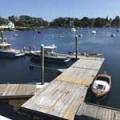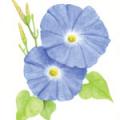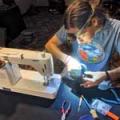Anneli Skaar’s Island Whale and Other Remarkable Works
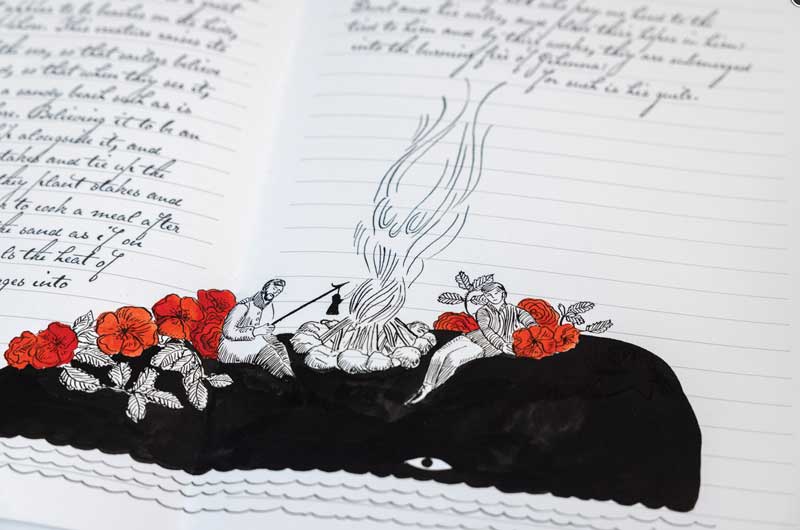 Skaar hand-drew the illustrations for all 30 copies of her artist’s book The Island Whale, including Physiologus, 2022, pen and ink with watercolor. Photo by Sean Carnell
Skaar hand-drew the illustrations for all 30 copies of her artist’s book The Island Whale, including Physiologus, 2022, pen and ink with watercolor. Photo by Sean Carnell
On August 16, 2024, the Thomas J. Watson Library at the Metropolitan Museum of Art began its Instagram post with this shout-out: “‘The Island Whale’ by Anneli Skaar (@anneliskaar) makes us want to drop everything and head out to sea!”
Accompanied by an image from the artist’s book, the Met post noted how the nine stories of whales being mistaken for islands “evoke imagery of rising sea levels as they sink below the surface.”
Skaar discovered the “island whale” while researching old pictorial maps. On pastor Olaus Magnus’s 1539 map of Scandinavia, she spied an image of seafarers dining on the back of a whale, having mistaken it for an island. Digging deeper, she found similar stories in other cultures—Persian, Icelandic, Irish—across the span of a thousand years.
Featuring Skaar’s illustrations and Arthur Larson’s letterpress printing, The Island Whale takes the form of a New England whaling log. Working with Larson and Amy Borezo at Two Ponds Press in Rockport, Maine, Skaar created a masterpiece that encompasses mythology, climate change, and deceptive cetaceans.
The book’s illustrations were to be letterpress like the text, but they didn’t look right in the proofs so Skaar hand drew all the illustrations in the 30 copies printed, which took her a year and a half. She left her job as creative director at the Farnsworth Art Museum in order to complete the work.
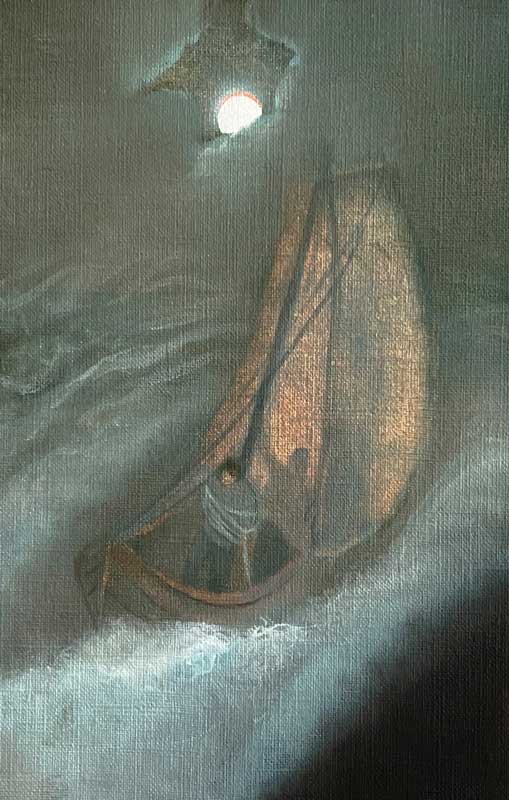 Lashed to the Mast, 2023, one of Skaar’s illustrations for Edgar Allan Poe’s story A Descent into the Maelström. Oil on oil paper, 8 x 5 in. Image courtesy the artist
Lashed to the Mast, 2023, one of Skaar’s illustrations for Edgar Allan Poe’s story A Descent into the Maelström. Oil on oil paper, 8 x 5 in. Image courtesy the artist
The Magnus map also featured the Moskstraumen, a real-life whirlpool—think the Old Sow off Campobello, but much larger and deeper—found in the Lofoten archipelago in Norway, Skaar’s ancestral home. Her fascination with this detail led her to Edgar Allan Poe’s short story “The Descent into the Maelström.” First published in Graham’s Magazine in 1841, the tale is based on that place of bountiful fish that has swallowed its share of mariners over the centuries.
Fascinated by Poe’s tale, in 2022 Skaar visited the whirlpool, which she likened to “being in a storm without any wind.” Wearing a flotation device, she rode out in a rigid inflatable—“a little dicey,” she admitted, but experiencing “the real deal” fired her imagination.
When Skaar learned that her great grandfather had fished for herring near the whirlpool, the story took on personal meaning. That her father was dying at the time of her visit added to the darkness of her images, some of which recall the moonlit sea paintings of Albert Pinkham Ryder. At the same time, she looked upon Poe’s narrative as a “perfect post-pandemic story: a tale of fear and grief but also of coping and survival.”
Her maelström series was shown at the Bromer Gallery in Boston and then at the Page Gallery in Camden last summer. The small oil-on-primed-paper works in vintage tintype frames riff on scenes from the story and the region: fishermen hauling nets, waters aswirl in fish, craggy islands poking up from the surf, a man lashed to the mast of a small wooden boat. They speak to Skaar’s expressive brushwork and her dark romantic vision of this ancient and mysterious mass of water.
 Skaar in her Camden studio standing in front of her painting Moonlight at Sherman’s Point. Photo by Alissa Hessler
Skaar in her Camden studio standing in front of her painting Moonlight at Sherman’s Point. Photo by Alissa Hessler
Artist from an Early Age
Skaar was born in San Francisco to Norwegian parents. Her father came to the U.S. in the early 1950s, and joined the military to get his citizenship (he changed his name from Skaarbrevik to Skaar for simplicity’s sake). Her mother arrived a few years later and they married in 1963.
Skaar wanted to be an artist from an early age. She became serious about this goal as she approached college, choosing to attend the Norwegian College of Art and Design in Oslo. Her parents talked her into going into illustration instead of painting, thinking it a more practical avenue.
Skaar graduated in 1992 with a bachelor degree in graphic design, but she continued to paint. For a while she worked in the studio of Odd Nerdrum, one of Norway’s best-known artists, who introduced her to Rembrandt. She also loves Chardin and Käthe Kollwitz (her first art purchase was a lithograph by the German printmaker).
Skaar moved to Camden in 2005. Through her 20s and 30s, she did design work to make a living. She never took herself seriously as an artist even though she painted whenever she could. Then in 2014, while struggling as a single mom with a young child she made a New Year’s Eve-type resolution: paint a painting every week.
To hold herself accountable, Skaar began posting her work online. The response to her small landscapes and still lifes was immediate: “It just went nuts,” she said. Before long, she had gained a following and was selling work left and right. A one-day pop-up show, “ICEHARDSHIPBEAUTY,” of 25 or so of her paintings organized by Camden art consultant Heather Hearst sold out. She had gotten back on the painting track.
“Emboldened” by her success, Skaar applied for the first of what would be a remarkable series of artist residencies. Living in Maine, she had come to love the palette and theme of winter and wanted more of it. Where to go? Like painter Rockwell Kent, she headed as far north as she could, to Svalbard, an archipelago in the Arctic Ocean in Norway. She went there in February, the darkest time of year, known by the nautical term “civil twilight” when the light appears six degrees below the horizon.
To pay for the trip, Skaar pre-sold 20 sketches of the Arctic at $200 a pop, which helped her purchase supplies. In addition to painting, she wrote constantly, penning a collection of short essays that became the book The Shittiest Coffee at the Top of the World, which she crowd-sourced to print.
Several of the pieces related to climate-related issues, but were written in a humorous and accessible way. Melting ice in Svalbard has led to a boom in the tourist trade—the last chance to see this iced-in world, as it were. Svalbard is also the home of the Global Seed Vault, which safeguards plant species in case of a global catastrophe.
Upon her return, Skaar showed her Arctic paintings at the Carver Hill Gallery in Rockland. Still feeling wanderlust, she arranged in 2016 through the Maine North Atlantic Trade Commission to be an artist in residence on an Eimskip container ship, the Selfoss, out of Portland. She and photographer Jonathan Laurence traveled from Maine to Iceland via Newfoundland, a “really rough” voyage in February. Skaar wrote and painted in her cabin while trying not to throw up. Google “Selfoss Logbook” to read an account.
The following year Skaar created her own residency, in Ilulissat, in western Greenland; once more, the compass pointed north. Spurred by her ongoing interest in climate change, she visited the largest iceberg calving area in the northern hemisphere. She again fundraised with paintings, some of the same patrons signing on for more art—and stories.
In 2018 Skaar stayed home, but continued her focus on northern themes. She and photographer Sal Taylor Kydd set out to visit a group of Maine islands in winter. These trips resulted in an installation, A Part of the Maine, in the Center for Maine Contemporary Art’s 2018 Biennial.
The collaboration featured Kydd’s framed platinum-palladium photographs of island scenes and Skaar’s large painted folding screen which shows the islands as seen from the mainland on one side and the opposite view on the other. She attached a chunk of granite to hold the screen in place but also as a “sort of symbolic anchor.”
From North to West
Perhaps a bit winter weary, Skaar headed for the Arizona-Mexico border for her next adventure. She and artist Mark Kelly set out to spotlight the work of a non-denominational group that was leaving water in the desert for migrants who were crossing illegally, some of them dying on the way.
Their project, “The Other,” consisted of cyanotype prints developed in their rented Ford Fiesta out in the desert. They created a photo collage that emulated the Great Seal of the United States that is found on the passport. The story and images appeared in the Hawk & Handsaw Journal of Creative Sustainability.
In researching passports, Skaar discovered one that connected her to Norway. As High Commissioner of Refugees for the League of Nations, the Norwegian polar explorer Fridtjof Nansen (1861-1930) conceived of a passport for stateless persons following World War I, a humanitarian act that helped earn him the Nobel Peace Prize in 1922. Encouraged by Liv Rockefeller and Ken Shure at Two Ponds Press, Skaar produced a fine press book that re-imagined the Nansen passport as a document for climate refugees, “in the context of environmental migration.”
Printed in an edition of 60, the book was launched in March 2020 as the pandemic unfolded so Skaar missed out on trips to the Explorers Club in New York City and the United Nations in Switzerland to give book talks (she did so on Zoom). There was, however, a silver lining: with everything online, news of the book spread far and wide. Nansen’s Passport is now in many eminent collections, including the Library of Congress.
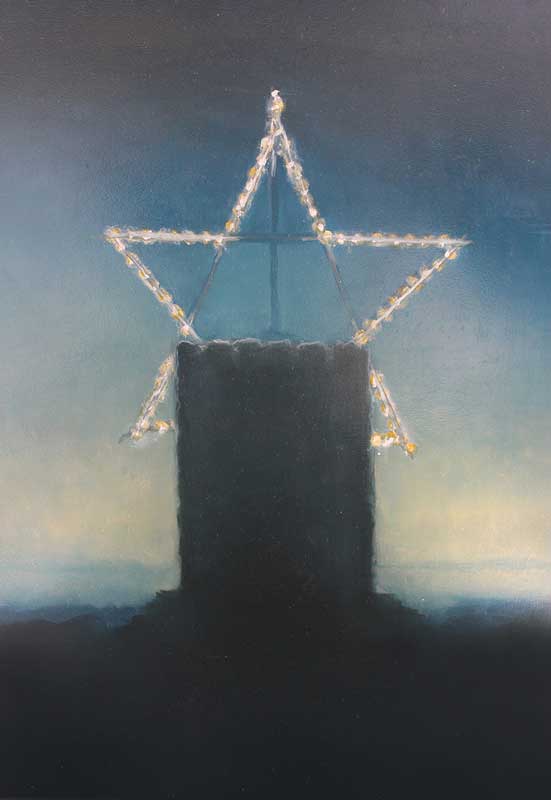 New Year, 2014, the first painting sold at Skaar’s first exhibition, depicts the star on Mount Battie on New Year’s Day. “I always think of that star as a wish for better things in the coming year,” she writes. Oil on cradled wood panel, 10 x 8 in. Image courtesy the artist
New Year, 2014, the first painting sold at Skaar’s first exhibition, depicts the star on Mount Battie on New Year’s Day. “I always think of that star as a wish for better things in the coming year,” she writes. Oil on cradled wood panel, 10 x 8 in. Image courtesy the artist
Even as she was finding success in the world of artist’s books, Skaar painted. The pandemic put a damper on her travels but not on her work. Painting and writing, she sought to capture what was going on at the time and the feelings she had.
In addition to a book of short essays, Skaar mounted “Dandelion Life” at the Page Gallery. The exhibition featured small landscapes and floral still lifes based on her surroundings, including several paintings of the Curtis Island Lighthouse (she had vowed to avoid this clichéd subject, but succumbed). She framed each painting in cardboard from Amazon packaging.
Stuck at home, Skaar decided to take up another art form: paper flowers. She took a class and fell in love with this new meditative practice. Ephemeral yet time- and labor-intensive, the flowers made the perfect gift and she sold some. Today, she teaches paper flower-making.
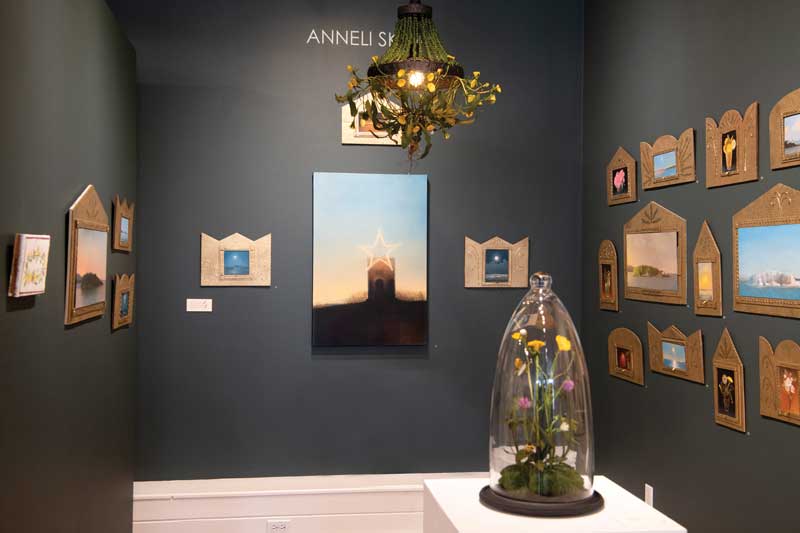 In the work featured in her 2022 exhibition “Dandelion Life” at the Page Gallery, Skaar sought to respond to her feelings about the world during the pandemic. Photograph by Sal Taylor Kydd
In the work featured in her 2022 exhibition “Dandelion Life” at the Page Gallery, Skaar sought to respond to her feelings about the world during the pandemic. Photograph by Sal Taylor Kydd
For the past six years Skaar has rented an apartment and studio on the outskirts of Camden, a stunning spot that overlooks the aforementioned Curtis Island Lighthouse and a part of Islesboro’s southern archipelago that includes Lime and Lasell islands. She holds workshops there, an idyllic spot for creative enterprises.
With a son entering commercial airline pilot school in Norway and with other expenses, Skaar became director of marketing at Maine Media Workshops in Rockport in 2024. She loves the job, which includes access to the book arts studio and free programs—“and it’s only two miles away.”
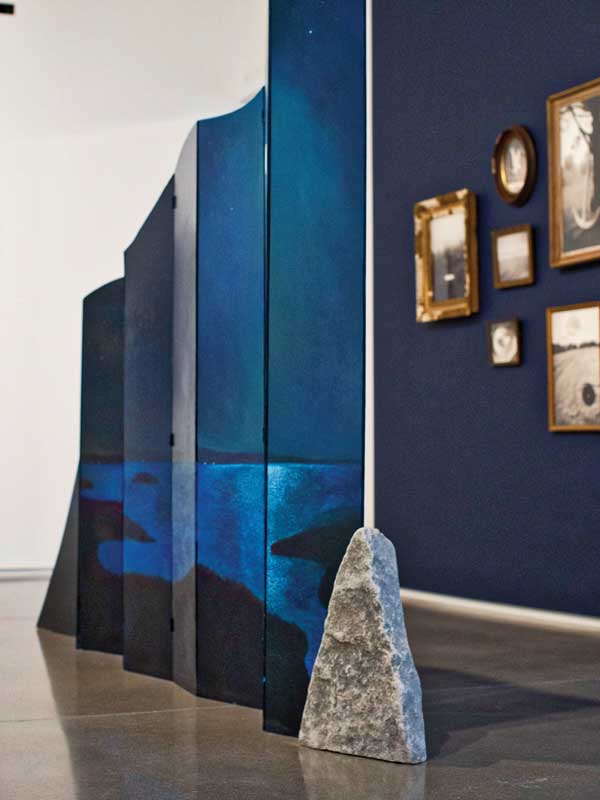 Skaar teamed up with photographer Sal Taylor Kydd to create A Part of the Main featured in the Center for Maine Contemporary Art’s 2018 Biennial. Photograph by Sal Taylor Kydd
Skaar teamed up with photographer Sal Taylor Kydd to create A Part of the Main featured in the Center for Maine Contemporary Art’s 2018 Biennial. Photograph by Sal Taylor Kydd
Describing her diverse creative activities—painting, producing artist’s books, leading workshops, designing fabric patterns—Skaar expressed her satisfaction for the way things have turned out. Seated in her studio on a mild late-September day, with schooners sailing by close enough to hear their sails flapping, she was feeling restless with the world but ready to embark on new projects. “I feel very fortunate to be where I am,” she said, and you could understand why.
✮
Carl Little is an MBH&H contributing editor and lives on Mount Desert Island. His latest publications are the monograph John Moore: Portals (Marshall Wilkes) and Blanket of the Night: Poems (Deerbrook Editions). His essay “The Pond of Life” appears in the anthology Alive to This (Littoral Books).
For More Information
Skaar is represented by the Page Gallery in Camden, Maine. You can learn more about her life and work on her website, anneliskaar.com.
Related Articles
Share this article:
2023 Maine Boat & Home Show

Join Us for the Maine Boat & Home Show!
Art, Artisans, Food, Fun & Boats, Boats, Boats
August 11 - 13, 2023 | On the waterfront, Rockland, Maine
Click here to pre-order your tickets.
Show is produced by Maine Boats, Homes & Harbors magazine.








